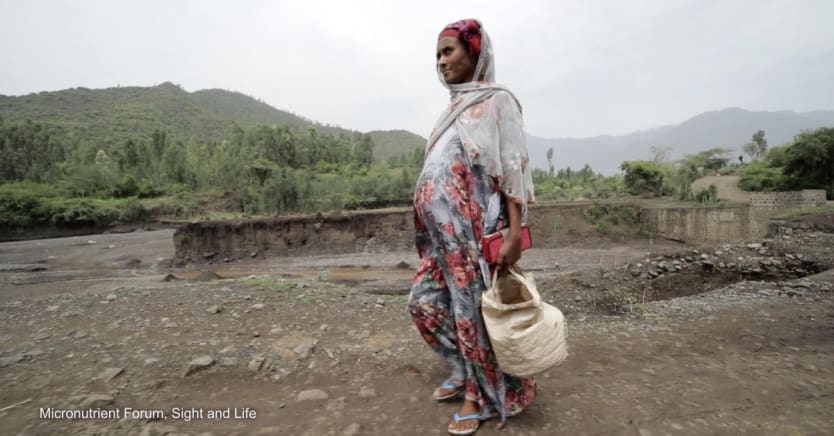
For women, pregnancy is a special yet physiologically demanding time when the nutritional needs to nourish the growth and development of a baby are higher. Without compensatory dietary intake, the mother’s nutrient stores can be depleted.
Unfortunately, healthy and nutritious foods are either unavailable or unaffordable for approximately three billion people globally. Millions of women also eat last and least due to social and cultural norms and practices that result in women serving their families first and eating what is left. For most, this does not change during pregnancy — the most critical time for their unborn baby’s development.
Poor diet leads to a deficiency of micronutrients such as iron, iodine, and folic acid that is otherwise known as hidden hunger. Such deficiencies during pregnancy can result in exhaustion, lower resistance to disease, and increased mortality risk for the mother. It can also lead to miscarriages, stillbirths, low birth weight, and, as the child grows, malnutrition, impaired cognition, reduced school performance, and lower future earning potential.
It is time for donors, governments, multilaterals, technical and implementing agencies, global and national companies to invest in better and more prenatal nutrition and health services.
—Anemia in women remains an intractable problem for which no country is on track to reach the World Health Assembly target of 50% in anemia reduction by 2025.
Women and girls have also been hit hardest by the COVID-19-related food and economic crises. In fact, it’s estimated that there will be an additional 4.8 million anemic women in 2022. Most of these will be women living in low- and middle-income countries. This isn’t surprising because poor maternal nutrition is a real matter of inequity. Of the babies born with low birth weight, 91% are in LMICs.
For example, in Ethiopia, 29% of pregnant women are already anemic and 22% are undernourished. Consequently, 20% of babies are born with a low birth weight. In India, almost half of all women of reproductive age are anemic, approximately one-quarter of women have low body mass index, and around one-third of babies are born with low birth weight.
Improving maternal nutrition prevents human capital losses
If more investment was made into ensuring women had access to the nutrient-dense food and supplements they need during pregnancy, the gains wouldn’t just be seen in the women and children of today, but impacts would be seen over generations.
A recent study showed that investing in prenatal nutrition interventions such as providing iron-folic acid, calcium, balanced energy-protein supplementation, or multiple micronutrient supplements — MMS — could equate to billions of dollars through gains in school years and lifetime income.
This is why it is high time to take the evidence-based, cost-effective interventions that are already available to scale. For example, MMS is a comprehensive prenatal vitamin and mineral supplement which was designed in 1999 by UNICEF, WHO, and United Nations University.
Scaling a lifesaving intervention: Skin-to-skin for mothers and babies
Kangaroo mother care was pioneered at a maternity unit in Bogota, Colombia in 1978. But the intervention has not been scaled up as widely as it could, considering its lifesaving potential. Efforts are underway to change that.
Following 20 years of research it has been proven that — in the absence of accessible and affordable nutritious diets — MMS improves maternal nutrition status and leads to favorable pregnancy and birth outcomes. It significantly reduces the risk of babies born with low birth weight, or being small for gestational age, and stillbirths and may also have long term benefits for child cognition. Yet it is still not widely available to women in LMICs.
The recent inclusion of MMS in the World Health Organization’s essential medicines list is a great step forward in encouraging governments and development agencies to step up and explore the feasibility and efficiency of introducing this lifesaving intervention through antenatal care services, but more must be done.
If MMS were to reach 90% of pregnant women across 132 LMICs, then it’s estimated that an additional 5.02 million school years and $18.1 billion in cumulative lifetime income would be gained. Iron-folic acid, or IFA, is another example, for which the gain would be 2.28 million school years and $8.26 billion, respectively.
Such large numbers are difficult for anyone to comprehend. But it is even harder to understand why we are failing so many women, girls, and future generations when we have evidence-based, cost-effective interventions, such as MMS, which are ready to be scaled.
The potential of such prenatal supplementation to prevent loss to human capital and to economies is staggering to the point of sounding abstruse. Thankfully, there are some initiatives helping to push for progress.
Actions to improve maternal nutrition
During the first United Nations Food Systems Summit this year, a Coalition on Making Food Systems Work for Women and Girls was formed. This will be an important driving force for women’s nutrition.
The Healthy Mothers Healthy Babies Consortium, hosted by the Micronutrient Forum since March 2020, has also been accelerating collective action to improve maternal nutrition and give a healthy start to mothers and their babies. Born out of the 2019 Goalkeepers Accelerator, it brings together actors from private sector, academia, civil society, and the U.N. who are working to increase demand, supply, and delivery of high-quality MMS. The consortium wants to see a world where all girls, women, mothers, and their babies, are healthy and thriving.
Another key opportunity is coming up this December, when the Japanese government will host the global Nutrition for Growth Summit, a commitment-making moment for nutrition.
Together these moments and initiatives signal that it is time for donors, governments, multilaterals, technical and implementing agencies, global and national companies to invest in better and more prenatal nutrition and health services and scale up evidence-based, cost-effective interventions to improve nutrition for women and girls.
Together we can ensure that women are well-nourished and have healthy pregnancies.
For more information on contributing to, and making, maternal nutrition commitments, see our maternal nutrition and MMS commitment-making guide.






